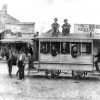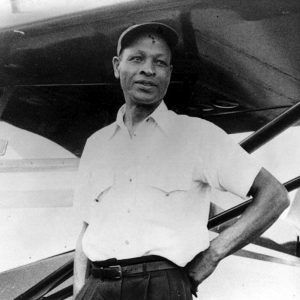calsfoundation@cals.org
Cornelius Robinson Coffey (1903–1994)
Cornelius Robinson Coffey was the first African American to establish an aeronautical school in the United States. His school was also the only aviation program not affiliated with a university or college to become part of the Civilian Pilot Training Program (CPTP). His pioneering efforts led to the integration of Black pilots into the overall American aviation industries, both civilian and military.
Cornelius R. Coffey was born in Newport (Jackson County) on September 6, 1903, to Henry Coffey and Ida Wright Coffey. In 1916, Coffey had his first experience riding in an aircraft and was convinced that aviation was his calling.
In 1925, Coffey left Arkansas for Chicago, Illinois, to pursue a career in aviation by enrolling in an auto mechanics’ school. It is unknown if he finished high school in Arkansas. In Chicago, Coffey and another Black man named John C. Robinson, a founder of the Challenger Air Pilots Association, attempted to enroll in aviation programs in Chicago but were not allowed due to racial segregation. Coffey and Robinson both improvised with help from a Black businessman who owned a vacant store lot, where they built aircraft motors. They built a one-seat airplane powered by a motorcycle engine and taught themselves to fly.
In 1929, Coffey and Robinson attempted to enroll in the Curtiss-Wright School of Aeronautics. They were initially accepted but when it was discovered on the first day of class they were African American, they were dismissed. With the assistance of their former employer, Emil Mack, a Chevrolet dealer, they orchestrated a campaign to sue the Curtiss-Wright School of Aeronautics because they were rejected on the basis of ethnicity and skin color. The school relented and admitted Coffey and Robinson, who enrolled in the aviation mechanics’ training course. Two years later, they became two of the top graduates. In 1932, Coffey became the first African American certified aircraft mechanic. He was also the first African American to hold both a pilot’s and mechanic’s license simultaneously.
Meanwhile, in 1931, Coffee and Robinson established the first Black-owned airport in the town of Robbins, Illinois, a predominately African American community, because the city of Chicago would not provide them a permit. The airport was constructed using volunteer labor and had a single hangar. In 1933, a windstorm destroyed the airport, and it was never rebuilt. A historical marker today indicates the spot where it was located.
In 1938, Coffey established his own aeronautics school. His school, the Coffey School of Aeronautics at Harlem Airport, was located south of Chicago at 87th Street and Harlem Avenue in Oaklawn, Illinois. Coffey employed highly qualified pilots such as Clyde Hampton and Willa Brown. Hampton would eventually leave the school to assist in the Tuskegee Institute military training experiment, and Willa Brown would become Coffey’s wife. Coffey and Brown married in 1939.
Coffey became one of the main reasons why (outside of Los Angeles, California) Chicago was the epicenter of Black aviation in the 1930s. Many of the documented original Tuskegee airmen got their first taste of aviation at the Coffey School. In 1939, Coffey, along with his wife—who was the first African American member of the Civil Air Patrol—and Enoch P. Waters, opened the National Airmen’s Association of America. The Coffey School’s goal was to send black aviators to the military and expose all minorities to aviation. This goal would be fulfilled by another method when the federal government asked the school to send cadets to Tuskegee. Coffey was not in favor of a segregated unit at the Tuskegee Institute, but his opinion would not halt the process of training African Americans in the South.
Coffey was a recipient of the Charles Taylor Master Mechanic Award from the Federal Aviation Administration (FAA) and, in 1980, was the first African American to have an aerial navigation intersection named after him by the FAA. The “Cofey Fix”—only five letters are allowed—is a waypoint located on the VICTOR 7 airway over Lake Calumet that provides electronic course guidance to Chicago Midway Airport Runway 31 Left. He also designed a carburetor heater that prevented icing and thus allowed airplanes to fly in all kinds of weather. Devices similar to his are still in use on aircraft today.
Coffey became the first president of the National Airmen’s Association of America and flew until he was eighty-nine years old. He died on March 2, 1994, in Chicago.
For additional information:
Broadnax, Samuel L. Blue Skies, Black Wings: African-American Pioneers of Aviation. Lincoln, Nebraska: University of Nebraska Books, 2008.
“Cornelius Coffey And The Tuskegee Airmen.” CafRiseAbove.org. February 1, 2013. https://cafriseabove.org/cornelius-coffey-and-the-tuskegee-airmen/ (accessed February 6, 2024).
Davis, Edmond Pioneering African-American Aviators: Featuring the Tuskegee Airmen of Arkansas. Little Rock: Aviate Through Knowledge Productions, LLC, 2012.
Gubert, Betty Kaplan, Miriam Sawyer, and Caroline M. Fannin. Distinguished African Americans in Aviation and Space Science. Westport, CT: Greenwood, 2001.
McCall, Matt. “Robbins Gave African-Americans Access to the Skies.” Chicago Tribune, February 10, 2017. https://www.chicagotribune.com/suburbs/daily-southtown/ct-sta-robbins-airport-st-0212-20170210-story.html (accessed November 17, 2023).
Hardesty, Von. Black Wings: Courageous Stories of African Americans in Aviation and Space History. Washington DC: Smithsonian, 2008.
Laughead, Amanda. “Cornelius Coffey: Aviator and Educator.” National Air and Space Museum, Smithsonian.edu. February 14, 2023. https://airandspace.si.edu/stories/editorial/cornelius-coffey-aviator-and-educator (accessed February 6, 2024).
Edmond Davis
Arkansas Baptist College
 Transportation
Transportation World War II through the Faubus Era, 1941 through 1967
World War II through the Faubus Era, 1941 through 1967 Cornelius Robinson Coffey
Cornelius Robinson Coffey 



Comments
No comments on this entry yet.